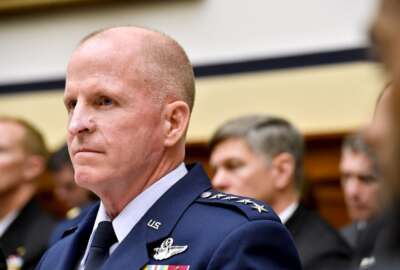
Military services chiefs say 2017 CR would be the worst yet
The top military leaders of each branch say the cumulative effect of years of continuing resolutions is taking its toll. But what makes 2017 so much worse than all...
The military services are no strangers to continuing resolutions.
Congress hasn’t passed a budget on time for seven of the last eight years. This year Congress is working on borrowed time again for its 2017 budget. The federal government is operating under a CR until at least April 28.
The military services are crying foul since they aren’t getting the money promised to them for new start programs and planned expansions. The military service chiefs from each branch told Congress in April that a full year CR would be detrimental to military readiness.
But what makes 2017 so much worse than all the other years?
Army Chief of Staff Gen. Mark Milley said it’s not 2017 in particular, but the culmination of all the previous CRs from the past.
“It’s the cumulative effect. We’ve been doing CRs now for eight years and a shutdown in [20]13,” Milley said during a House Armed Services Committee hearing. “It’s like smoking cigarettes. One cigarette is not going to kill you, but you do that for eight, 10, 20 years, 30 years you’re eventually going to die of lung cancer.”
The chiefs railed against CRs and their new status as commonplace within the budget process.
Milley said the failure to pass a budget is “constitutional professional malpractice.”
“I don’t think we should accept [CRs] as the new normal. I think we should pass [the budget] and the supplemental with it,” Milley said.
The supplemental is a $30 billion budget proposed by the Trump administration that injects $25 billion into restoring the readiness of the military services by paying for modernization and maintenance.
The service chiefs aren’t the only ones sending up warning signals. The vice chiefs said a year-long CR would leave their branches with deficits compared to what they originally budgeted.
The Air Force would be out about $1.3 billion.
“If I broke [the $1.3 billion deficit] into chunks … to get after $500 million of flying hours, that’s about two months of flying time. To get after $500 million of weapons support means I have to stop our depot production. To get after the rest of it means anything that breaks across our military, I can only fix it if it breaks. … I’d stop civilian hiring, I’d shut down depots and I’d have to stop flying to fix a $1.3 billion math problem,” Air Force Vice Chief of Staff Gen. Stephen Wilson said.
The Army is facing an even bigger deficit from the funds it expected to receive.
The service expected a $4 billion increase in direct readiness for 2017. If a yearlong CR becomes a reality that money will not be delivered.
“We are going to run out of money in mid-July on the current spend rate and when that happens all the readiness gains that we’ve been building for 2 1/2 years are going to start that trip down the precipice. That’s a significant near-term problem. The longer term problem is the hundreds of new start programs that are delayed,” Army Vice Chief of Staff Daniel Allyn said.
The military services spelled out exactly what would take a hit during a yearlong CR in a document sent to Congress last week.
The Navy, for example, would cut back flight hours across all of its aviation operations. Four of the nine carrier air wings that aren’t already deployed would be shut down entirely, and about a third of the Navy’s newest pilots wouldn’t be able to finish their initial training. That would leave squadrons undermanned by 20-to-30 percent by the end of the year, causing shortages that the Navy said would have ripple effects for the next several years.
The Marine Corps, likewise, would cancel flight operations for 24 squadrons, “significantly worsening” the already large aviation readiness problem it’s faced since the last time it grounded planes during sequestration, officials said.
The Air Force would have to put a stop to the plan Congress approved last year to grow its active duty force to 321,000 airmen, deferring about 2,000 new recruiting actions until 2018 or later, and about 13,000 troops would have their permanent change of station orders canceled in order to save on moving expenses. The Navy would take similar steps, delaying shore duty orders until 2018, stopping most of the bonus payments it offers for critical skills and cutting new recruiting by about 1,000 sailors.
The Army also said it would not be able to recruit and pay enough soldiers to meet the end strength Congress has already authorized, may have to stop paying enlisted troops their monthly allowances for food and might have to cut off all payments to West Point cadets because of the “imbalances” a full-year CR would cause in its military personnel accounts. In addition, it would cancel or delay several brigades’ training rotations through the National Training Center and Combined Training Center.
Still, the Defense Department isn’t exactly stingy with its money either.
Critics are worried the defense budget is becoming unbearably bloated with waste and lawmakers are just throwing more money at the problem.
DoD is the only government agency that is not audit ready. It is not fully accountable for the money it spends.
A high profile 2015 report from the Pentagon stated DoD could save $125 billion over five years just by cutting contractors and streamlining some practices. That money could be saved without firing a single person.
“The growth in Defense infrastructure has been continuous. The tendency has been to add, rather than subtract. As we have added more staff, more layers and more infrastructure, we have slowed the decision process, expanded the number of players and made the overall system more risk averse, at a time when we need to take more risk and make quicker decisions,” Arnold Punaro, a member of the Defense Business Board, told the Senate Armed Services Committee in 2015.
The DoD is spending more now than it spent during the peak of President Ronald Reagan’s buildup of the military. However, war fighting forces are 40 percent to 50 percent smaller, Punaro said. He added that infrastructure within DoD is costing about $240 billion and using more than 1 million people.
Copyright © 2024 Federal News Network. All rights reserved. This website is not intended for users located within the European Economic Area.
Scott Maucione is a defense reporter for Federal News Network and reports on human capital, workforce and the Defense Department at-large.
Follow @smaucioneWFED
Related Stories





